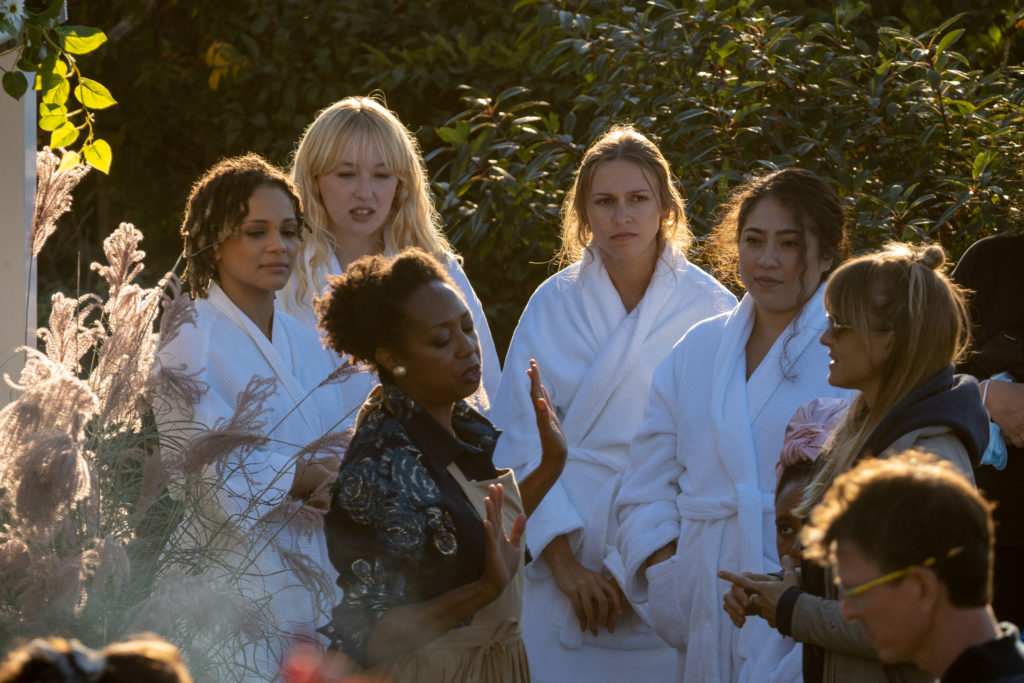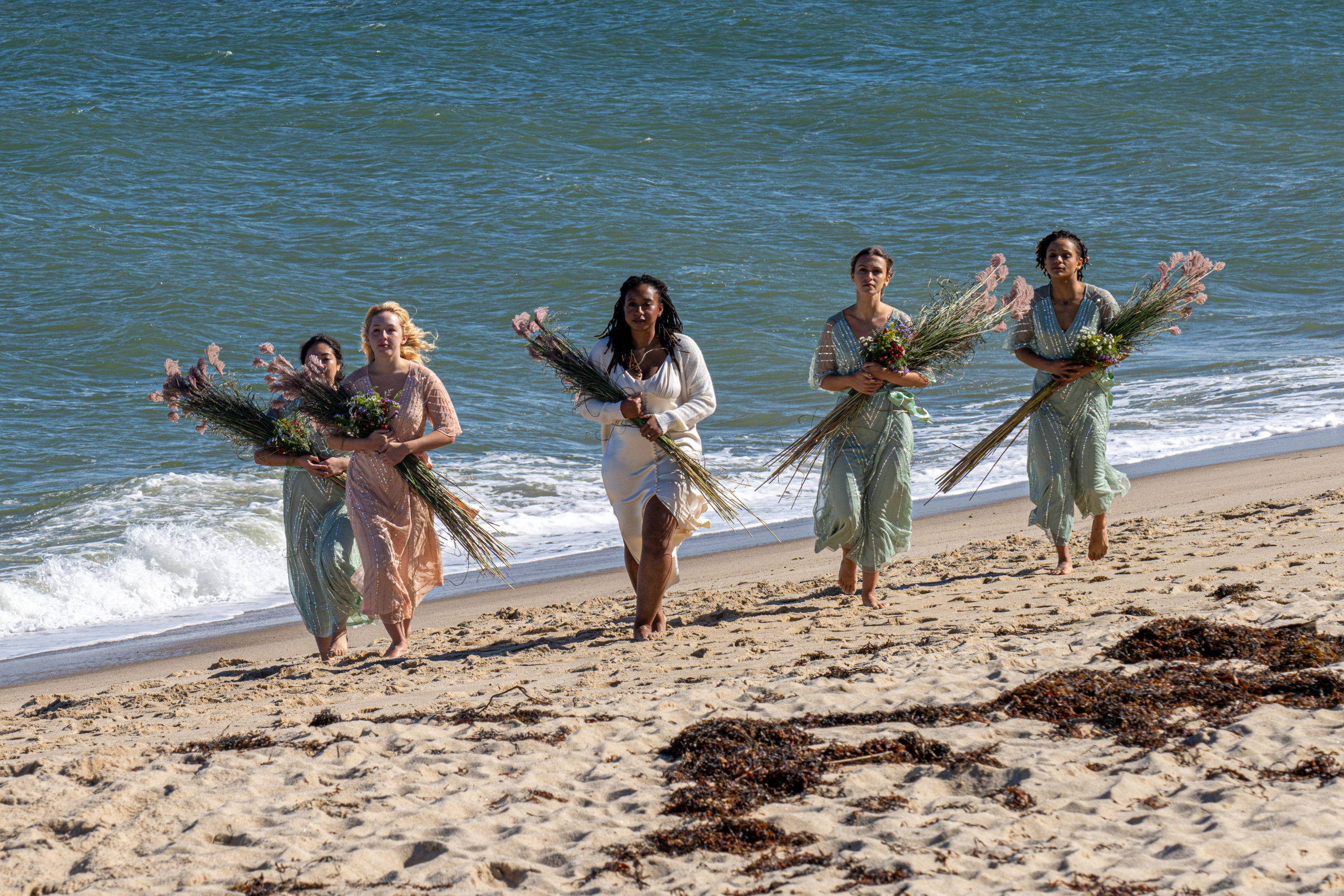Shura Baryshnikov on the Role of Dance in the New Cinematic Opera She Directed
In the new, dance-centric film version of the opera Svadba, director Shura Baryshnikov, screenwriter Hannah Shepard and conductor Daniela Candillari tell a powerful wedding story using Serbian-born, Montréal-based composer Ana Sokolović’s a cappella music and text. Throughout, the film uses dance to enact various prenuptial rituals for the bride-to-be and her attendants.
Baryshnikov (a daughter of Mikhail) brings her experience as a dancer, actor, improviser, choreographer and head of movement and physical theater for the Brown University/Trinity Rep MFA program, making her a natural pick for directing an opera film in which the movement is as dynamic as the voices. Shot in Massachusetts’ Cape Cod, the work is available now through the end of the year on Boston Lyric Opera’s operabox.tv and the Opera Philadelphia Channel (operaphila.tv) streaming services. She recently spoke with Dance Magazine about how the film came together.
How did this collaboration come about?
I’ve worked with Boston Lyric Opera a number of times before. Brad Vernatter, the acting general and artistic director, contacted me and said that they had selected this piece of music—Ana Sokolović’s Svadba—for their season. When he listened to it, he immediately thought this will make an incredible dance film and asked me if I wanted to direct.
Previous stage versions of Svadba have the six characters singing and embodying the roles. What went into the decision to separate the actors/dancers from the singers for the film?
With screenwriter Hannah Shepard, who’s also my sister, we landed on the concept of having the singers be essentially this kind of ancestral chorus that’s helping usher the ritual of the day through. It felt clear to make a one-to-one relationship between the two casts. The only thing that we did that’s really a departure from the libretto is that we carved out this role for an elder family member, Lena, as the maternal figure or aunt. The libretto writes about the bride-to-be and the attendants, but we really wanted this intergenerational component because that’s such a huge part of so many life events, the presence of family members from the previous generation, the way that they know the rituals and, with their strength and wisdom, guide the younger generation through times of change.

In addition to being intergenerational, your cast is racially diverse, and the wedding depicts a queer marriage.
I didn’t have any hand in the casting of the singers—and I had no attachment to telling a white heteronormative story. Considering that Chabrelle D. Williams, who was singing the role of Milica (the bride), and Brianna J. Robinson, who was singing the role of Lena (the aunt), were the two Black singers, it felt absolutely necessary to cast Black women in those corresponding roles in the contemporary dance ensemble. And it felt like a clear directive saying this should be a story about African-American women.
Jackie Davis was cast as Lena: She’s an incredible mover, she can handle any dramatic or theatrical action. And then Victoria Awkward just has a calmness and a kind of center that I was really desiring for the role of Milica.
Talk about the setting and the movement language. What places and/or traditions influenced the dancing in the film?
We decided to embrace the place that we were in. I mean, we were not in a forest in Serbia (the setting of the libretto), we were in Boston and we were going to be shooting local. I’m deeply interested in place and being truthful about place and environment. Then, considering the ocean and considering the kind of cyclical nature of change in one’s life, metaphors of water and waves and tides…that’s how we ended up on the Cape.
As far as the movement vocabulary, I’m a collaborative choreographer. It’s a big piece—50 minutes of material. Certainly not all of that is dancing, but there were places that I knew we would need to work with improvised scores, where there were musical landmarks and prompts, as well. But ultimately a lot of that material came from the dancers. Jackie is of Jamaican heritage and influenced by Afro-Caribbean dances and other dances of the African diaspora. I really wanted to work with those movement vocabularies that were emergent in the cast. I facilitated a lot of improvisational exploration to answer “How would this woman move, and what would her history be?”
In many ways it felt like the movement was a gift to the bride.
Yes. The quartet that happens in the living room, which is kind of a call-and-response, felt like they are kind of performing almost a skit for the bride. They embody these traditional folk songs and they are playing this antagonist, like masculine and feminine energy, almost tongue-in-cheek stereotypes for her in the moment. And then there are the games on the beach, and that whole section is almost like nursery rhymes or a round-robin structure—someone goes into the middle and dances and comes back out and chooses someone else to go in.
I was looking for ways that the dance could emerge in places that felt really organic. I never had the sense that we would dance our way through this whole piece, but that the dance would live in the places that needed that expressive quality for storytelling.
The close-up shots of the singers’ faces are interspersed with the storytelling and dance. The singers’ role in the story seemed to shapeshift. How much of that was written into the script and how much of that happened in the editing process?
The vocal production in this piece is so profound, right? The mouth percussion, the complexity of the vocalizations…Because it’s an a cappella piece, we really wanted audiences to see these faces, to see them making these sounds. It felt important to honor their contribution more than just in the soundscape. So once we made that choice, we certainly had ideas of where the presence of the singers as ancestors felt most powerful, like when the bride goes to the ocean alone—moments that needed that ancestral support in the storytelling to understand she has a kind of spirit world around as well as the flesh and blood members of her community. I think we needed the ancestors’ support in moments of vision or tonal shift. So they are supporting her dreamworld when she’s sleeping on the beach, they are playing and they have their hand in this whole unfolding of events and the way that she’s experiencing her reality.
How does this film fit in with your oeuvre?
This is my first professional film project of this kind of scale. You know, I’ve made small dance films during the pandemic like many people, playing around and learning how to do some of my own editing. But, quite honestly, I have a complicated relationship with film in the sense that once the material is set, that’s all you have to work with. I love the maturing of live performance over a rehearsal process and performance series, and I’m an improviser, so I struggled a little bit with wanting there to be more opportunity to let it evolve. But I did love the editing process with Gil Seltzer—I deeply enjoyed fine-tuning draft after draft.
I’m open to doing more film projects, though I certainly still consider myself primarily a practitioner of live performance. My collaborative relationships are the most important thing for me. Bringing this beautiful cast together in an environment where they felt confident and deeply empowered to make personal choices in their movement vocabularies has made me incredibly grateful.




